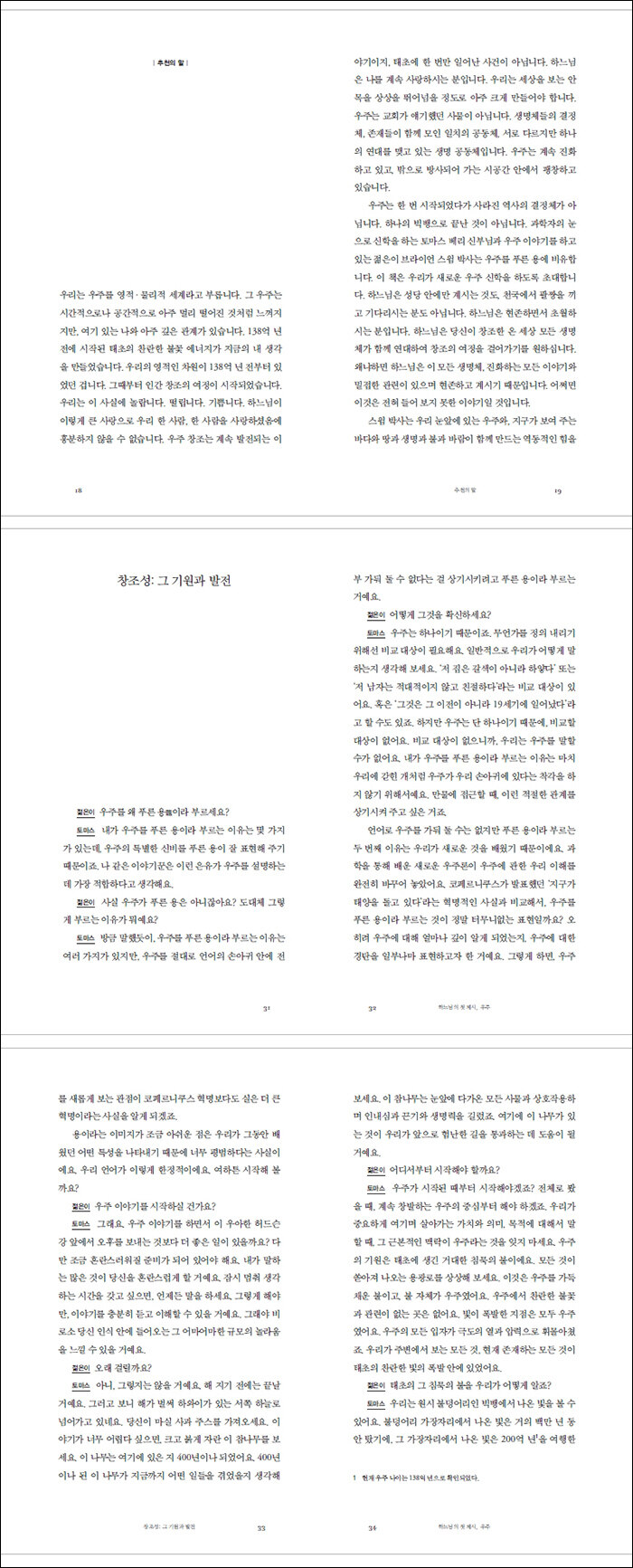알라딘: 우주는 푸른 용
우주는 푸른 용 - 매혹적인 우주의 창조 이야기


브라이언 스윔 (지은이),허찬란 (옮긴이)분도출판사2019-12-12
원제 : The Universe Is a Green Dragon: A Cosmic Creation Story

이 책 어때요?
192쪽
140*215mm
250g
책소개
지금 당신의 창조성을 일깨우며 경이롭게 펼쳐지는 우주 이야기. 138억 년 전, 거대한 침묵의 불이 있었다. 존재하는 모든 것들, 모든 생명, 나아가 우리 인간의 기원을 거슬러 올라가면 이 태초의 불덩어리가 있었다.
물리학자 브라이언 스윔은 우리에게 새로운 우주 이야기를 들려준다. 두 사람이 하룻저녁 나누는 짧은 대화를 통해 우주의 기원과 발전을 돌아보며 ‘우주 안에’ 살고 있는 인간 생명의 의미와 역할을 살펴보고 모색한다.
스윔에 따르면 우주는 단지 물질 충돌의 우연한 결과에 그치는 것이 아닌, 계속해서 발전하는 어떤 존재에 더 가깝고, 우리 인간 또한 이 창발하는 우주에 참여하고 있다. 이 책은 독자들을 새로운 우주 신학으로 초대한다.
목차
한국의 독자들에게
추천의 말
서문
1. 하느님의 첫 계시, 우주
창조성: 그 기원과 발전
매혹
우리의 운명, 환희
우주의 위험과 기회에서 오는 악: 핵 과학과 핵무기
2. 하느님의 창조물, 지구
바다
땅
생명
불
바람
3. 빅뱅의 절정
변화: 사회와 지질 활동
우주의 불이 찍어 내는 예술
감사의 말
역자 용어설명
접기
---
책속에서
P. 36 가장 놀라운 일은 우주에 존재하는 모든 것이 같은 기원에서 출발했다는 사실을 깨달은 거죠. 내 몸을 이루는 원소와 당신 몸을 구성하는 원소가 본질적으로 연관되어 있다는 것이 믿어지세요? 그들이 빅뱅이라는 단일 에너지 사건에서 나와서 포획되었기 때문이죠. 우리 족보를 따라 올라가면, 우리 조상은 생명체를 거쳐 별들로, 그리고 태초의 원시 불덩어리까지 올라가요. 우주가 물질과 정신, 지성과 생명의 다양한 형태로 된 단일한 에너지 사건이라는 것은 정말 새로운 사실이에요. 인류 역사의 위대한 인물 중 그 누구도 이 사실을 몰랐어요. 플라톤이나 아리스토텔레스, 이스라엘의 예언자들과 공자, 토마스 아퀴나스와 라이프니츠, 뉴턴 등 세상에 큰 업적을 남긴 그 누구도 이 사실을 몰랐죠. 우리는 경험적 관점에서 우주의 기원을 알아 가는 최초의 세대인 셈이죠. 우리는 밤하늘을 올려다보며 우주와 은하와 별들이 탄생하는 사건을 전체적으로 이해하는 최초의 인간이에요. 하나의 생물 종(種)으로서 인간의 미래가 우주 이야기에 새롭게 새겨질 거예요. 접기
P. 84 우주와 지구 안에 들어 있는 폭력을 통해 성취된 뛰어난 아름다움을 우리는 알고 있어요. 하지만 이와 동시에 인간에게도 같은 일이 일어날지 아직은 몰라요. 실제로 인간은 수천 년의 문명기 내내 거의 멈추지 않았어요. 인간이 지구 생명 체계에 유익한 새 가족인지 깊게 생각하지도 않았죠. 인간은 자아도취(narcissism)에 빠져 자신의 생존과 타고난 자기의 힘을 탐구하는 데만 집중했죠. 인간 활동을 평가할 수 있는 더 큰 세계관, 즉 별과 식물과 다른 모든 생명체를 포함한 보다 큰 우주 공동체라는 안목을 발전시키질 못했어요. 정확히 말하면, 생물 종種의 하나인 우리의 제한된 좁은 세계관 때문에 지구가 망가지고 있는 거죠. 만일 우리가 더 큰 세계적 안목을 원한다면, 지난 1천만 년 동안의 지구 역사를 살펴봐야 해요. 접기
P. 133 그래요. 죽음은 끔찍하죠. 그것을 하찮게 생각하지 마세요. 죽음 위에 당신의 하찮은 생각을 투영하지 마세요. 그러나 죽음의 인식을 연료나 램프처럼 이용하세요. 즉 당신 속에 있는 미지의 신비스러운 동굴로 당신을 안내해 줄 은밀한 안내자로서 죽음을 이용하는 거예요. 그러면 당신의 참자아를 끌어낼 수 있을 거예요. 당신의 창조성은 에너지를 얻기 위하여 죽음을 인식하는 걸 필요로 하죠. 근육을 만들려면 계속 운동을 하면서 고통과 스트레스로 좀 단련을 받아야 하는 것처럼, 당신도 아픔이 있어야 깨달을 수 있죠. 죽음에 대한 인식을 우주가 당신에게 주는 선물로 여기고 소중히 간직하세요. 매 순간 무한히 심오한 의미를 보게 해 주는 이런 방법이 없다면, 당신 인생을 살아가도록 이끌어 줄 힘이 어디에서 나올까요? 접기
---
추천글
과학자의 눈으로 신학을 하는 토마스 베리 신부님과 우주 이야기를 하고 있는 젊은이 브라이언 스윔 박사는 우주를 푸른 용에 비유하며 우리를 새로운 우주 신학으로 초대합니다.
- 강우일 (한국천주교주교회의장 주교)
---
저자 및 역자소개
브라이언 스윔 (Brian Swimme) (지은이)
대중적 물리학자이며, 과학적 우주론 분야의 세계적 전문가이다. 1978년 미국 오리건 대학교에서 중력 역학에 관한 연구로 박사 학위를 취득했다. 이후로 우주 진화 역학만 아니라 과학적 우주론과 전통 종교의 관계, 우주 이야기(Universe Story)의 문화적 의미와 인류 역학 등을 연구했다. 1998년에는 새로운 우주 이야기에 관심을 갖는 과학자와 예술가, 생태학자, 종교학자, 교육자를 위한 국제 포럼 EES(Epic of Evolution Society)를 설립했다.
현재는 캘리포니아 융합학문 대학원 교수로 진화 우주론을 가르치며, 우주 이야기 센터를 운영하고 있다.
1982년 메튜 폭스와 함께 첫 책 『지구 문명 선언문』Manifesto for a Global Civilization을 썼다.
- 『우주는 푸른 용』The Universe is a Green Dragon 외에
- 『우주 이야기』The Universe Story(토마스 베리와 공저),
- 『우주 속으로 걷다』Journey of the Universe(공저)가 우리말로 옮겨졌다.
최근작 : <우주는 푸른 용>,<우주이야기> … 총 3종 (모두보기)
허찬란 (옮긴이)
저자파일
천주교 제주교구 사제이다.
1998년 사제 서품을 받고, 로마 교황청립 안토니오 대학교에서 가톨릭 사회교리를 수학했다.
미국 홀리네임즈 대학교와 캘리포니아 융합학문 대학원에서 새로운 우주론을 공부했다.
현재는 브라이언 스윔 박사와 우주 이야기를 탐구하고 있다.
출판사 제공 책소개

지금 당신의 창조성을 일깨우며
경이롭게 펼쳐지는 우주 이야기
자본이 모든 것을 판가름하는 것처럼 보이는 시대에 살면서, 자연과 하나가 되는 경험을 하기가 쉽지 않은 세상이 되어 버렸다. 그러나 머리를 들어 밤하늘의 별을 바라본 경험은 누구에게나 있을 것이다. 안개 낀 새벽 강변에서 거룩한 상념에 들거나 짙푸른 바다 앞에서 신선함을 호흡하고 깊은 숲에서 경외감에 빠져 본 경험도 있을 것이다.
『우주는 푸른 용』은 이러한 경험의 원천에 무엇이 있는지, 우리는 지금 어디로 향하고 있으며 어디로 향해 가야 하는지에 대해 알기 쉬운 대화체로 풀이해 준다. 우리의 우주적 여정을 감동적으로 전하는 이 우주 이야기는 과학에 근거한 최근의 우주론을 보여 주지만 딱딱한 과학서가 아닌 아름답고 색다른 영성 서적으로 다가온다. “인류 역사에서 가장 무서운 병에 걸린 우리는 물질적인 우주로부터 영적인 우주를 분리한 일이 정말 좋은 생각이었는지 물어야 한다.”(24쪽)
저자에 따르면, 우리의 우주적 여정은 한 종(種)으로서 우리가 참된 성숙에 이르는 과정이며, 이 길에서만, 그리고 오직 이 길만이 지구를 다시 꽃피게 할 것이다. 우리가 우주에 속해 있는 종이라는 성숙한 의식을 갖고 다른 생명체와 상호연관성을 의식한다면, 우리는 생태 위기에 놓인 지구를 살릴 수 있다고 낙관한다.
새로운 우주 신학으로 초대하는 이 책은 ‘생성 중인 우주’라는 관측에서 출발하여 우리의 출처와 우리의 본성과 우리의 미래에 대해 이야기한다. 지구적 차원에서 살아간다는 것과 우주적 차원에서 인간 생명이 지니는 의미를 곱씹어 보게 함으로써 우리의 시야와 사고를 한층 넓고 깊게 만들어 준다.
이 책에는 하느님이라는 말이 전혀 없다 (장 제목에 예외적으로 두 차례 나오지만, 이것은 역자의 친절한 번역일 뿐 원서에는 나오지 않는다). 아마도 브라이언 스윔은 하느님을 전혀 언급하지 않으면서 하느님에 대해 이야기하고자 했을지 모른다. 신앙인이라면 브라이언 스윔의 우주 이야기를, ‘하느님에 대한 말이 없는 하느님 이야기’로 이해해도 좋을 것이다.
이 책은 웅장하고 광대한 차원으로 독자를 초대하며 새로운 눈을 뜨게 함으로써 독자 역시 그 차원에 속해 있음을 알려 준다. 저자는 한국의 독자들을 위해 쓴 서문에서 인간 삶의 목적을 간결하게 제시한다. “우리는 우주 안에 잠재되어 숨겨진 아름다움을 낳기 위해 여기에 있다.”(17쪽) 접기
종교와 과학이 어떻게 만나는지... 우리 안의 신비를 끌어내어 줄 책이네요.
shymoon 2019-12-13 공감 (0) 댓글 (0)


